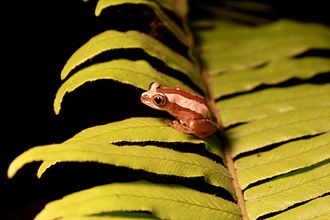Type the name of the breed you're looking for below
[wpdreams_ajaxsearchlite] Don't see the breed your're looking for? Click here and let us know!
Banana Brown Frog
| Place of Origin and Range | The Banana Brown Frog, also known as the Striped Spiny Reed frog, is found in Angola, Cameroon, Republic of the Congo, Democratic Republic of the Congo, Ivory Coast, Equatorial Guinea, Gabon, Ghana, Guinea, Liberia, Nigeria, Sierra Leone, and possibly Togo. |
| Description | Dark with the snout continuing into a broad stripe to the groin. A light spot in the lumbar region, sometimes confluent with the stripes, and two light spots on tibia, or tibia uniformly light. Although normally constant in pattern, individuals in some populations can vary considerably. |
| Adult Size | Can grow up to 1.5 in(4 cm) |
| Accommodation | These frogs "prefer habitats with plentiful floating vegetation, grasses, and cattails" and are often found in "small ponds, large lakes, marshes, and streams also can be found at night in a backyard swimming pool. Unlike many amphibians, they do not require artificial heating. They need a large (at least ten-gallon) terrarium and do best with a substrate that will hold some humidity, such as commercial shredded bark or coconut husk bedding, or untreated topsoil on the floor of their terrarium. A shallow water dish should be included. Captive frogs should not be handled any more than necessary; when necessary, clean gloves should be worn. . A source of UV light is not required, and ambient temperature of 72 to 77 °F (22 to 25 °C) is sufficient. |
| Lifespan | Can live 5+ years |
| Feeding / Diet | These frogs are insectivores, usually consuming flies, mosquitoes, and other small insects such as crickets. One study suggested the frog selects prey not by its size, but according to its activity level, with the most active prey being the most frequently eaten. |
| Breeding | These frogs have been known to spontaneously change sex from female to male. This likely occurs when the population does not have enough males to allow procreation and is accomplished when a chemical trigger activates the sex gene to disintegrate the female organs and develop the male ones. |



